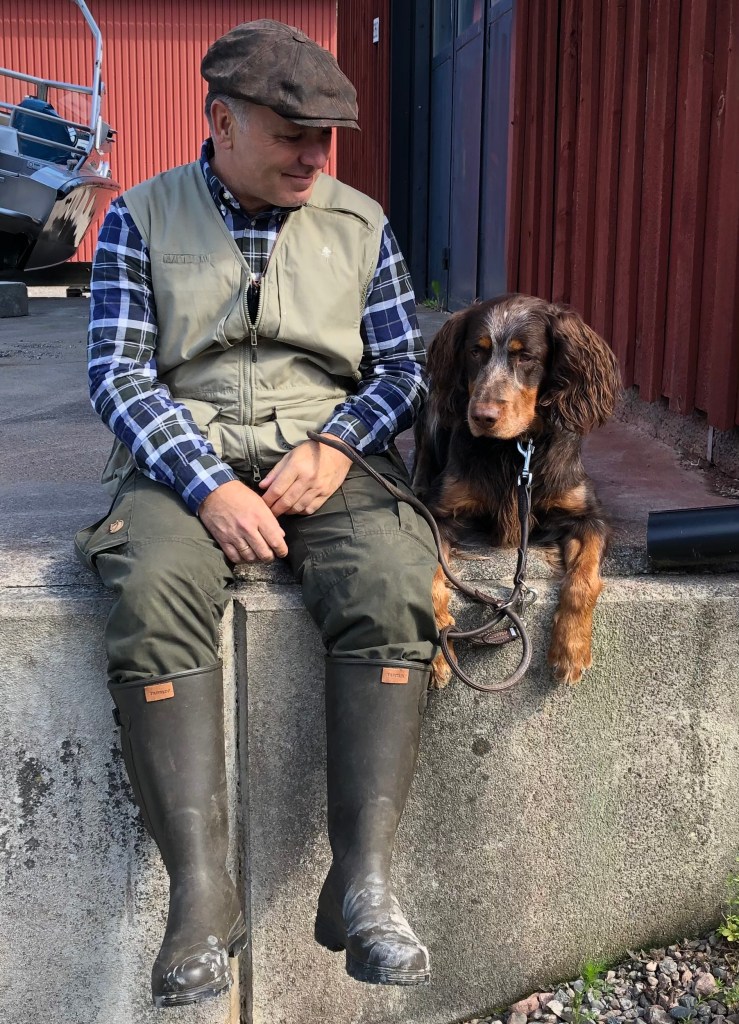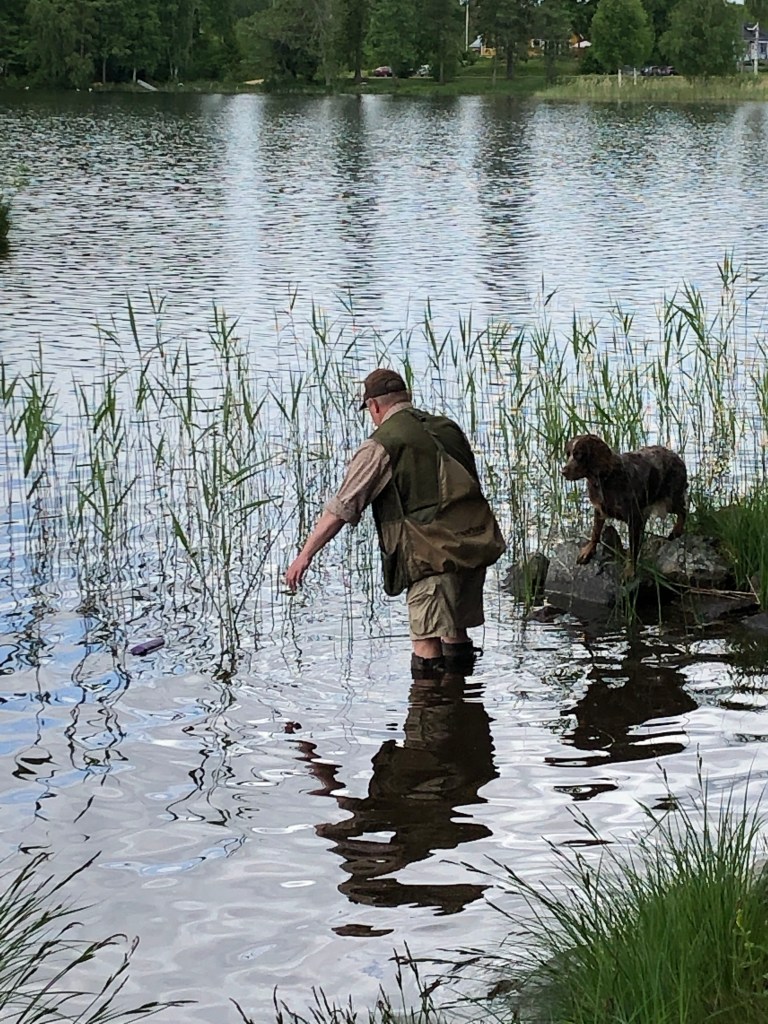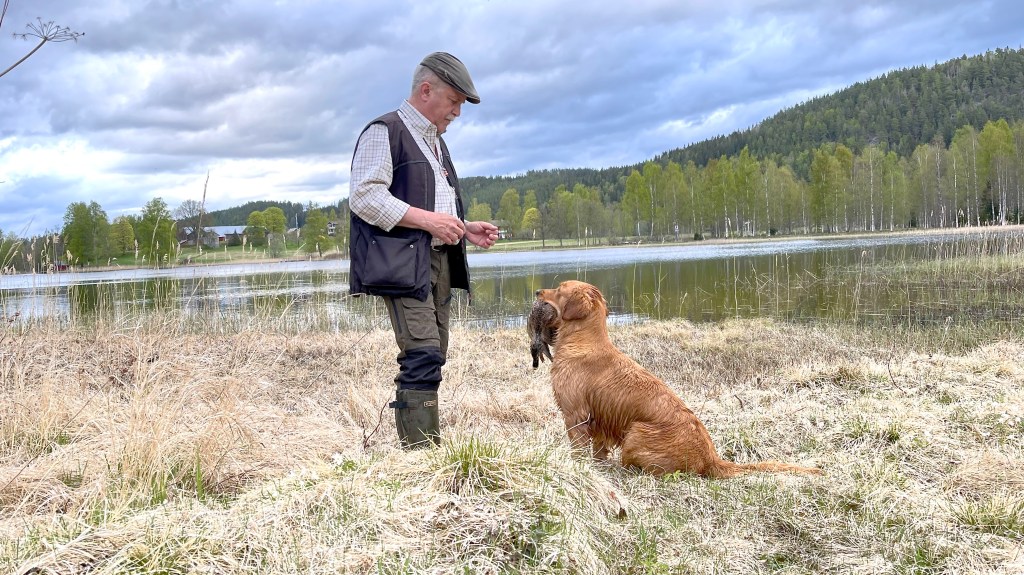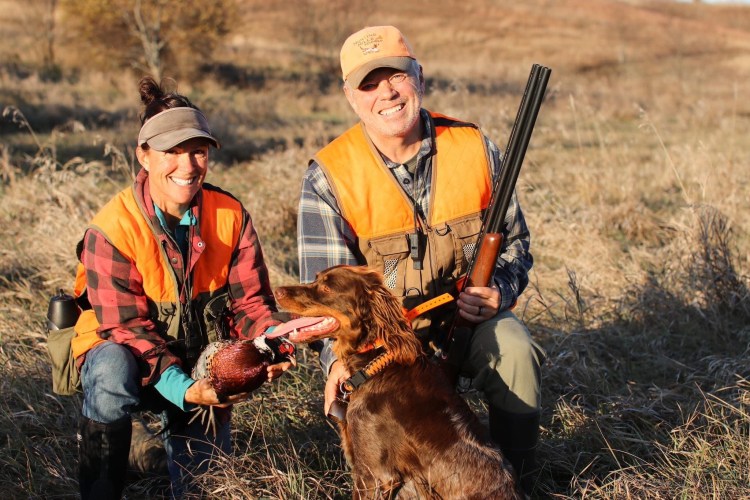-

Ric, Maria of Hayabusa Kennels and Celine
In 2022 Ric Plath and Ellen Bergfeld of Castiron Kennels traveled to Sweden to attend Hayabusa Kennels annual Training Clinic and Field Competition. In addition to meeting with breeders and Picardy Spaniel owners from Sweden, Norway, Finland and the Netherlands, Ric and Ellen judged the competition. The group was comprised primarily of Picardy Spaniels, but there were also a few Curly Coated Retrievers and a lone Golden Retriever. In addition to observing some great dogs in action, they made many new friends. And, they took away some excellent training tips from European trainers and owners/handlers to share with Picardy Spaniel owners in North America. Some are new and others are great reminders of good training practices.
Hayabusa Takeaway #1: Training Cadence

In Europe the training fields are quite small, typically less than 10 acres. The first portion of the competition was called a “Training Line,” which was new to us. The gentleman far left is a professional trainer who acted as the field marshal. He lined everyone up at one end of the field and then he would walk along asking all handlers to manage their dogs at heel…or “foote” in Swedish. At various intervals he would stop, throw a bumper and when the bumper hit the apex he would shoot a starter pistol. All dogs were expected to remain at heel. The field marshal would then point to a dog and handler at random and the handler would cast their dog. This was a new drill for some of the dogs and handlers. Some dogs were excited and wanted to retrieve every bumper. Some dogs had a tough time staying at heel. One dog was a bit gun sensitive. But the majority of the dogs managed the retrieve and presentation just fine.
At the end of the session the trainer provided input to each of the handlers about their dog. What we might refer to as “the good, the bad and the ugly.” He suggested that training is not a ladder, but rather a roller coaster that should always be moving upward. The goal is very small “ups,” and not to have any large “downs.” It reminded us of the saying: “Inch by inch, it’s a cinch. Yard by yard is too hard.” Expecting too much too quickly of any dog will result in failures that are not the fault of the dog, but rather the fault of the trainer. This is especially true of young dogs. More harm than good will be the result of rushing things. Training and finishing a bird dog takes time and patience.
Hayabusa Takeaway #2: Obedience

Obedience training is the foundation of hunt training. It doesn’t matter what country you live in, nor what game you hunt, it’s foundational. You simply cannot expect success in hunt training if your dog doesn’t respect you and have basic manners. Dogs should be good citizens, and owners, whether they like it or not, are dog trainers. It comes with owning a dog. A dog is a carnivore and a pack animal. S/he is not a child, even though some training resembles that of child rearing. The dog owner is the alpha male/female of the family…the dogs pack…which means they are the Top Dog. A “benevolent dictator” as one trainer suggested, but not in a mean, spiteful or punitive way…that doesn’t work well with Picardy Spaniels.
The Top Dog is the teacher and the dog is the student…a student who doesn’t speak your language. A student who is much more adept are reading body language than you, and also very tuned in to your emotions. And a student who is the equivalent age of a 2-year old. But, s/he is a willing student who will do almost anything to please the Top Dog. And s/he is a very food motivated student as well. Always start with the basics. Sit/Stay. Come. Heel. Kennel. Whistle Work. Waiting/Place. Etc. The dog runs the accelerator. The Top Dog navigates and steers. When the basics are well understood then add in the hunting training. A dog’s natural instincts aren’t going to disappear with age. So, take the time the student needs to master basic obedience before getting too serious about hunt training.
Hayabusa Takeaway #3


Nothing new here, but a few good reminders. First, if the water is too cold for you to wet wade, it’s too cold for any water introductions. Second, swimming is basic training while water work is more advanced. Don’t try and introduce both at the same time. Swimming should be perceived as something fun at first, so find a gently sloped pond and go play with your puppy in the water. You first…because you’re the alpha. The puppy won’t want to be left behind so s/he will join you. Splash around a bit and give your pup plenty of praise. Once your dog is swimming well you can start with water work, but not before. And your dog should be fetching well on land before you throw the first bumper out for a water retrieve.
A couple other reminders regarding water work. Meet your dog right at the waters edge in a kneeling position when you begin water work.
- By assuming a less commanding position the likelihood is that your dog will keep swimming toward the bumper vs looking back at you.
- Never praise nor encourage the dog until after the bumper is picked up and you’ve made eye contact with the dog. It helps them stay focused on the bumper.
- Always start with a fairly large orange bumper so the dog doesn’t get confused by seeing a lily pad flap in the breeze or a by a white/yellow lily pad flower. You can move to smaller and more natural colored bumpers once the dog understands the game and is getting good at it.
- And from the first bumper toss always meet the dog at the waters edge to prevent a dog from learning to “drop, shake.” It’s a bad habit that will take time to correct.
Hayabusa Takeaway #4

Retrieving training reminders and tips…in no particular order…
- Clap or shoot a starter pistol at the apex of a bumper throw to simulate hunting conditions.
- Walk one step forward on a release/cast with young dogs to get them started in the right direction. Don’t talk during their track/search as not to break their focus. Don’t praise them until they have the bumper and you can make eye contact. At that point walk backward one step to encourage a direct return to you.
- Always use a check cord with young dogs during retrieve training, whether on land or in the water.
- Never send a young dog on a retrieve without having a second bumper handy so you can get them a win even if they can’t find the first bumper.
- If things go poorly with retrieve training use a different bumper during the next session so your dog doesn’t associate a particular bumper with a bad experience.
Hayabusa’s Training Clinic and Feild Competition was a great experience and an excellent opportunity to meet like-minded Picardy owners and breeders. People who have become friends and who are willing to help those of us who are working hard to ensure that the introduction of Picardy Spaniels in North America is a long-term success for the breed. We can’t thank Mia and Joergen enough for including us in the Hayabusa Training Clinic and Field Competition.


Ric, Ellen and their Picardy Pack live in New Glarus, WI, just 25 minutes southwest of Madison. An avid hunter, Ric has owned, trained and hunted Gordon Setters, Small Munsterlanders, and for the past 7 years, Picardy Spaniels. Ellen has an extensive background in animal genetics and a PhD in Reproductive Physiology. She bred and trained Greater Swiss Mountain Dogs prior to Picardy Spaniels.